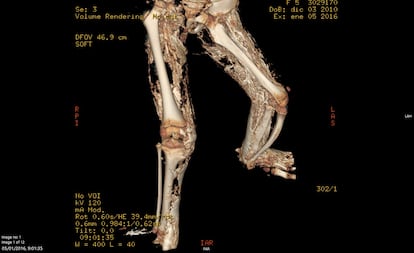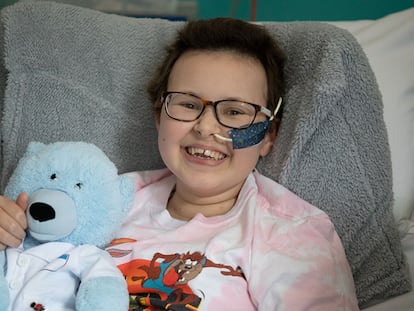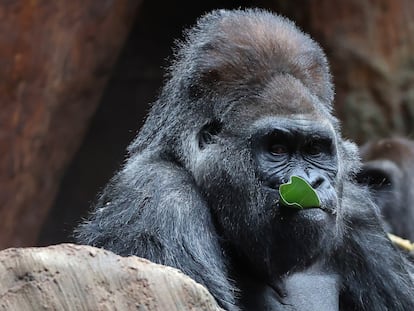The enigma of the girl who turns into bone while her identical twin remains healthy
Twelve-year-old sisters Cayetana and Celia share the same genetic mutation, but only one of them suffers from an extremely rare disease that turns muscle into bony plaques

An egg from Loló Suárez and a sperm from Eduardo Agraso merged one day in 2010 to form a single cell with the same DNA, from which two identical twin sisters, Cayetana and Celia, were born. Today both are 12, enjoy swimming at the beach by their village (Portosin, northwestern Spain) and share the same genetic mutation – although Celia has practically no symptoms, while Cayetana’s muscles are quickly turning into bone. A year and a half ago, the girl herself requested that both her legs, already petrified, be amputated to make her life easier. Pediatrician Federico Martinón Torres co-leads the medical team that works against the clock to understand why the disease has it in for one sister and respects the other. Celia could hide the secret, or at least a clue, to cure the pathology. “It seemed like a perfect experiment: two identical people, one sick and the other healthy, but it’s not turning out to be so obvious,” laments Martinón.
The girls have progressive osseous heteroplasia, an extremely rare disease that, according to the calculations of the American doctor Fred Kaplan, who discovered the disorder three decades ago, affects only a hundred people in the world. “This is the most serious case I know of,” explains the researcher. In Cayetana, the disease is explosive. If her parents notice a tiny callus under her skin on a Friday, by Sunday it could have turned into a sizable bony plaque. There is no preventive or curative treatment, beyond undergoing frequent surgeries to remove the new bone.
Martinón’s concern is evident. “We are always one step behind the disease,” acknowledges the doctor, head of Pediatrics at the University Clinical Hospital of Santiago de Compostela. “We have tried a lot of things, everything that made sense. And to date, we have failed. That is the truth,” he says. “You have a patient admitted, but you have nothing to offer her. Not only us: nobody in the world.”

Twins have such a special bond that “I” and “we” become interchangeable. Cayetana and Celia grew up happy in the fishing village of Portosin, but without understanding why, if they were identical, the disease was making them increasingly different. DNA is an instruction book that is present in every cell. It is written with approximately three billion letters, which are the initials of chemical compounds with different amounts of carbon, hydrogen, oxygen and nitrogen. The sisters’ mutation involves the loss of only four letters: G, A, C and T, the initials for guanine (C₅H₅N₅O), adenine (C₅H₅N₅), cytosine (C₄H₅N₃O) and thymine (C₅H₆N₂O₂). Those four missing letters cause the inactivation of the GNAS gene, which is responsible for preventing bone formation in the wrong place.
The bony plaques sometimes sprout like needles, explains the girls’ mother. “Caye has told me that she doesn’t know what it is to live a day without pain,” continues Loló Suárez. Desperate at the lack of research on the disease, in 2016 the parents decided to set up an organization to correct the situation: the Galician Association of Progressive Osseous Heteroplasia. They have already raised more than €200,000 ($225,000), mostly destined to financing the scientific team. But the clock keeps ticking. Cayetana, smart and cheerful, takes the amputation of her legs with a dose of dark humor. Just the other day, at home, her mother said, “It smells like feet in here!” To which the girl replied with a laugh: “Well, it’s not mine, mom!”
Geneticist Antonio Salas, co-director of the research group, explains his main hypothesis. The parents do not have the mutation, so it must have appeared after the fertilization of the egg, before the embryo split in two so the two identical sisters could begin to develop. If DNA is a sequence of letters, epigenetic changes are chemical compounds that act as punctuation marks that can alter the message. During the formation of eggs and sperm, these marks are added to the DNA and can cause a gene to be turned on or off, depending on whether it was inherited from the father or the mother. This complex phenomenon, known as imprinting, dictates the functioning of the GNAS gene, “one of the most complex in the human genome,” according to Salas.
The researchers believe that the two sisters share the same mutation, but Cayetana also has an imprint that causes the GNAS gene to be activated or deactivated in certain parts of her body. This is what scientists call mosaicism: the girl would have two types of cells, each with a different epigenetic composition. “This is all speculative. Unfortunately, we lack evidence. We could be completely wrong,” admits Salas, a professor at the Faculty of Medicine of the University of Santiago de Compostela.
The Mexican biochemist María José Currás presented her doctoral thesis, on Cayetana and Celia, in January. The document — which begins with a humble quote from 17th-century scholar Sor Juana Inés de la Cruz: “Study to ignore less” — lists all the efforts of the Santiago de Compostela group. The researchers have analyzed the letters of the DNA of the girls, the marks of their epigenome, the proteins produced with these genetic recipes and even the intermediary molecules. The difference between Cayetana and Celia has not appeared yet. “Progressive osseous heteroplasia, at the cellular level, behaves like cancer. Here the proliferation is of cells that produce bones, when they should not,” explains Currás.
Doctor Fred Kaplan discovered the disease in 1994 after studying 125 patients with fibrodysplasia ossificans progressiva (or Stoneman syndrome), another unusual pathology in which muscle turns to bone. Kaplan, from the University of Pennsylvania, noted that some of the affected people did not have the usual symptoms, such as a characteristic congenital malformation of the big toes, and described a new disease, with its own peculiarities. The American doctor has his own hypothesis: “I believe that the twins share the same mutation, but the most affected sister probably had a second mutation very early in the development of the embryo, in the GNAS gene itself or in another that interacts with it.”
Chemist David Liu from Harvard University is an international authority in the study of rare diseases of genetic origin. Liu also suggests the existence of “another disturbing factor” in Cayetana, either a second spontaneous mutation or a difference in gene regulation. “Those modulatory factors can be very difficult to find. It is unlikely that the doctors have been able to identify and rule out all possible genetic and epigenetic variations between the twins,” he told EL PAÍS.
Antonio Salas suspects that the solution to the enigma lies in epigenetics, but he does not rule out the second mutation hypothesis. “It is a possibility, but it is not my favorite bet. That would be like winning the lottery twice,” he explains. His colleague Sara Pischedda, an Italian biologist, explains that the team has already looked for these epigenetic differences in the blood of the twins. “The result was that the girls are the same,” she says. The next step is to look for differences in other tissues, such as Cayetana’s calcified skin, muscles and bones. “There is a whole world, and we are probably at the beginning,” warns Pischedda.
Loló Suárez and Eduardo Agraso continue to hope, but they do not deceive themselves. The amputations have not stopped their daughter’s illness. The muscles in her body continue to turn into bone. “We are realistic about the fact that something might not be achieved in time to help Cayetana, but we’ll be satisfied if all this money and the effort we have made can help any other child,” says Suárez. “I would also be the happiest mother in the world, even if it doesn’t come for my daughter.”
Sign up for our weekly newsletter to get more English-language news coverage from EL PAÍS USA Edition
Tu suscripción se está usando en otro dispositivo
¿Quieres añadir otro usuario a tu suscripción?
Si continúas leyendo en este dispositivo, no se podrá leer en el otro.
FlechaTu suscripción se está usando en otro dispositivo y solo puedes acceder a EL PAÍS desde un dispositivo a la vez.
Si quieres compartir tu cuenta, cambia tu suscripción a la modalidad Premium, así podrás añadir otro usuario. Cada uno accederá con su propia cuenta de email, lo que os permitirá personalizar vuestra experiencia en EL PAÍS.
¿Tienes una suscripción de empresa? Accede aquí para contratar más cuentas.
En el caso de no saber quién está usando tu cuenta, te recomendamos cambiar tu contraseña aquí.
Si decides continuar compartiendo tu cuenta, este mensaje se mostrará en tu dispositivo y en el de la otra persona que está usando tu cuenta de forma indefinida, afectando a tu experiencia de lectura. Puedes consultar aquí los términos y condiciones de la suscripción digital.
More information
Últimas noticias
Most viewed
- Reinhard Genzel, Nobel laureate in physics: ‘One-minute videos will never give you the truth’
- Oona Chaplin: ‘I told James Cameron that I was living in a treehouse and starting a permaculture project with a friend’
- Pablo Escobar’s hippos: A serious environmental problem, 40 years on
- Why we lost the habit of sleeping in two segments and how that changed our sense of time
- The fall of a prolific science journal exposes the billion-dollar profits of scientific publishing










































